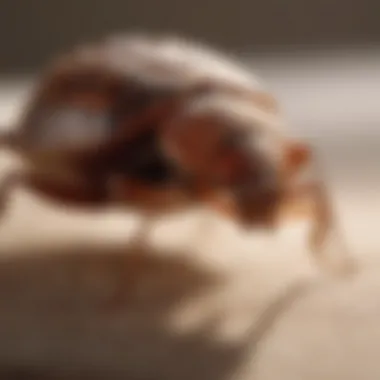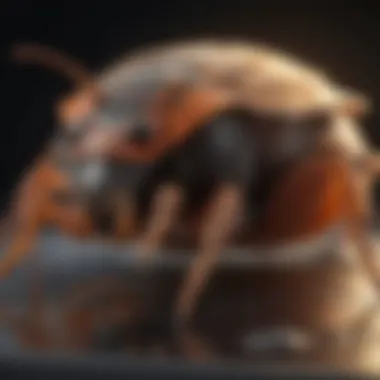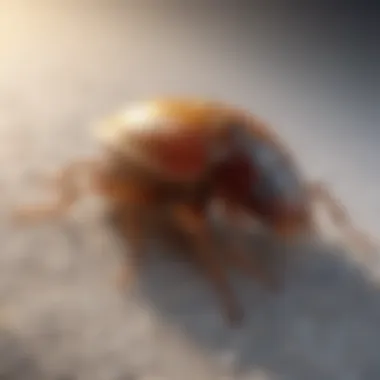Thermal Heat for Bed Bugs: An In-Depth Analysis


Intro
Bed bugs have become synonymous with discomfort and distress for many homeowners and renters alike. The pests, known for their elusive nature and resilience, can create significant challenges in a household. The advent of thermal heat treatment offers a promising avenue to combat these persistent nuisances. This article will provide a detailed exploration of the efficacy of thermal heat, examining not only its biological implications on bed bugs but also the process involved, its advantages, and potential drawbacks. By understanding the science behind thermal treatments, individuals can make more informed decisions when faced with a bed bug infestation.
Pest Identification
Identifying bed bugs promptly is crucial for effective management and eradication. Bed bugs, scientifically known as Cimex lectularius, are small, wingless insects that feed on human blood. Measuring about 4 to 5 mm in length, they have a flattened, oval shape and a reddish-brown color. Their size and color may make them difficult to spot, adding to their stealthy reputation.
Detailed Descriptions of Common Pests
Besides bed bugs, it's important to differentiate them from other similar-looking pests:
- Fleas: Smaller than bed bugs, usually around 1-3 mm, and often associated with pet infestations.
- Ticks: Larger than bed bugs, they also feed on blood but are more often found in grassy areas.
Signs and Symptoms of Infestations
Identifying an infestation may involve looking for:
- Bite Marks: Red, itchy welts on exposed skin, often in a line or cluster.
- Fecal Stains: Small, dark spots on sheets and furniture.
- Eggs and Shells: Tiny white eggs and remnants of molted skins can often be found in hiding spots such as seams of mattresses or cracks in walls.
The presence of any of these signs warrants immediate action to address the situation before it escalates.
Prevention Strategies
Prevention is often the most effective strategy when it comes to bed bugs. Once an infestation takes hold, it can become a daunting task to eliminate. Here are several strategies for prevention that homeowners should consider:
Home Maintenance Tips for Pest Prevention
- Regular Cleaning: Frequent vacuuming of carpets, furniture, and curtains can help in removing any potential bed bug hideouts.
- Declutter: Reducing clutter provides fewer hiding spots for bed bugs, making them easier to spot and manage.
- Seal Cracks and Crevices: Use caulk to close gaps and holes in walls, floors, and around furniture.
Natural Deterrents and Barriers
- Diatomaceous Earth: This natural powder can be spread in areas where bed bugs might enter. It dehydrates and kills the bugs on contact.
- Essential Oils: Oils such as tea tree or lavender have been found to repel bed bugs, though they may not eliminate them.
Treatment Options
When it comes to treating bed bug infestations, it’s vital to weigh options carefully. There is ongoing debate about the efficacy of chemical versus natural treatments. Each option has its own set of benefits and challenges.
Overview of Chemical vs. Natural Treatments
- Chemical Treatments: Professional exterminators commonly use products like pyrethroids. These are potent but may require more than one application and can have residual effects that should be considered.
- Natural Treatments: These include approaches like heat treatment, which is often touted as a safer and effective means of eradication. Natural treatments generally lack harmful side effects but may take more time and effort to implement.
Step-by-Step Guide for DIY Treatments
For homeowners interested in tackling infestations using thermal heat:
- Preparation: Remove all items from the infested area and wash bedding and clothing in hot water.
- Heat Treatment: Use space heaters or specialized equipment to raise the temperature of the affected areas to at least 118°F (48°C). Maintain this temperature for at least 90 minutes to ensure efficacy.
- Monitoring: Use bed bug monitors post-treatment to ensure the effectiveness of the process.
"Thermal heat treatment is known for its ability to penetrate all hiding spots of bed bugs, making it a thorough eradicating method when done correctly."
Implementing these strategies requires understanding and diligence. Although managing bed bugs is challenging, the insights provided will enable readers to confront these pests with confidence, leveraging thermal heat along with appropriate prevention tactics.
Preamble to Bed Bugs and Pest Control
Bed bugs, small parasitic insects that feed on human blood, pose a significant problem in households across the world. Their resurgence in the past decade has made pest control a critical topic for homeowners and landlords alike. Understanding these pests, the challenges they bring, and the available control methods is essential for effective eradication. This article aims to delve into these facets, with a focus on how thermal heat can address bed bug infestations.
Understanding Bed Bugs
Bed bugs belong to the Cimex lectularius species. They are often found in mattresses, bedding, and upholstery, making close contact with humans unavoidable during their feeding process. Adult bed bugs are reddish-brown, about a quarter-inch long, and can survive several months without feeding. Their ability to hide in tiny crevices complicates detection and eradication efforts. Overnight, they can cause significant distress by disrupting sleep, leading to both psychological and physical health issues. Awareness of their characteristics is crucial for effective prevention.
The Challenges of Bed Bug Infestations


Dealing with a bed bug infestation presents numerous challenges. First, their rapid reproduction can lead to a small problem becoming a massive infestation within weeks. Additionally, their elusive nature makes them difficult to find. Homeowners may not realize they have a problem until the infestation is advanced.
Furthermore, bed bugs are resilient against many traditional pest control methods. Pesticides that once proved effective are now often met with resistance. This increases the complexity of treatment and may necessitate a multi-faceted approach, incorporating various methods and tools for successful eradication.
Traditional Pest Control Methods
Many conventional pest control solutions exist, but each has its strengths and weaknesses. Chemical treatments typically involve pesticides, which can be effective when applied correctly. However, their effectiveness can decrease over time as bed bugs develop resistance. Furthermore, these chemicals can pose health risks to household members and pets, raising concerns about long-term exposure.
Another traditional method is the use of traps. While traps can assist in monitoring the severity of an infestation, they do not eliminate the problem. Instead, they often serve as a temporary measure. Homeowners should also consider vacuuming infested areas to physically remove bugs. However, this method requires strict procedures to ensure the bugs do not escape.
Thermal Heat Treatment Explained
Thermal heat treatment emerges as a prominent method for tackling bed bug infestations. Its importance lies in the ability to effectively eliminate bed bugs at all life stages without relying on chemical pesticides. This section delves into the various facets of thermal heat treatment, providing insights into the scientific principles, the specific impact on bed bugs, and the meticulous process involved in applying heat treatments.
The Science Behind Heat Treatment
Heat treatment utilizes the principle that bed bugs are sensitive to high temperatures. Scientific studies show that bed bugs cannot survive temperatures exceeding 122 degrees Fahrenheit (50 degrees Celsius) for prolonged periods. When heat reaches this threshold, it disrupts essential biological functions and ultimately leads to their demise. This method capitalizes on the thermal lethality to render a complete eradication of these pests.
The mechanism of heat treatment focuses on thermal transfer. Heat penetrates surfaces, accessing bed bugs hidden in cracks, crevices, and other shelters. This ensures not just surface extermination but also a thorough internal treatment, thus addressing the root of the infestation.
How Thermal Heat Affects Bed Bugs
Bed bugs are ectothermic insects, meaning their body temperature is regulated by their environment. When exposed to high temperatures, their physiological processes are significantly affected. Rapid heating can result in dehydration, disorientation, and death. The heat treatment process interrupts their reproductive cycle, making it harder for future generations to arise.
Moreover, the uniform distribution of heat in enclosed spaces allows for effective treatment of various hidden areas. Beneficially, heat can penetrate mattresses, upholstery, and carpet fibers, often housing bed bug nests.
Process of Thermal Heat Application
The process of applying thermal heat is elaborate and requires careful execution to ensure effectiveness. This involves several stages that must all be executed correctly.
Preparation Steps
Preparation is a critical phase that sets the stage for a successful thermal heat treatment. This step requires identifying the infested areas and clearing clutter to give access to surfaces where bed bugs may hide. By doing so, the effectiveness of the heat treatment is maximized.
A key characteristic of preparation is ensuring that all areas are inspected thoroughly. This makes preparation an effective strategy in the overall extermination process. The unique feature here includes assessing which items can withstand heat and those that need removal, ensuring the boundaries of the treatment are well-delineated. This step can save time and enhance safety during treatment.
Monitoring Temperature Levels
Monitoring temperature levels is another essential aspect of the heat treatment process. Accurate temperature readings ensure that the heat reaches the lethal levels for an adequate duration. This monitoring is typically done using thermal cameras or digital thermometers.
One vital characteristic of this step is that it ensures every corner of the treated space reaches the necessary temperature. Moreover, consistently checking temperature levels provides real-time feedback, vital for the success of the procedure. This precautionary measure helps to avoid areas that might not receive sufficient heat, which can lead to the persistence of bed bugs post-treatment.
Duration of Treatment
Duration of treatment refers to the length of time that heat is applied to the affected area. Studies indicate that a minimum of 90 minutes at 120 degrees Fahrenheit may be necessary for effective eradication. However, the time can vary depending on the degree of infestation and the structure of the specific environment.
A key aspect of this is that the duration must be sufficient to ensure complete lethality. Short treatments can miss critical areas, while overly long durations can risk damage to furnishings. Therefore, finding a balance in duration is beneficial for both treatment effectiveness and property safety.
"Heat treatment eliminates bed bugs where they hide, making it a comprehensive solution against these pests."
Understanding the thermal heat application process is crucial for those dealing with bed bug issues. Implementing these methods leads to better results and quality of life improvements in infested spaces. Overall, the tactical approach to heat treatment showcases its efficacy as an indispensable part of modern pest control solutions.
Advantages of Using Thermal Heat
Thermal heat treatments have gained interest as a solution against bed bug infestations. Their rise in popularity stems from the efficiency they exhibit compared to traditional methods. Thermo-therapy not only addresses the pest itself but also offers various benefits worth considering.
Effectiveness Against Bed Bugs
Thermal heat treatments have shown significant effectiveness in eradicating bed bugs at all life stages. Unlike chemical treatments, which may not affect the eggs of bed bugs, heat can penetrate surfaces and reach bugs hidden in corners, mattresses, and furniture. The specific heat range utilized typically ranges between 120°F to 140°F (approximately 49°C to 60°C). At this temperature, bed bugs cannot survive. Research and case studies consistently demonstrate near 100% mortality rates when these temperatures are sustained for the proper duration. Ultimately, heat serves as a proactive method, fostering long-lasting results and reducing the chances of re-infestation.
Environmental Considerations


With increased awareness regarding environmental impacts, thermal heat treatment stands out as a more sustainable option. Many households today seek methods that are both effective and minimal in ecological footprint. Unlike traditional extermination techniques that often employ potent pesticides, heat treatments utilize equipment that emits no harmful residual chemicals. This allows for a safer environment for both family members and pets. Additionally, the process requires less energy than one might expect, making thermal systems not just an effective choice but also a responsible one.
Non-Toxic Nature of Heat Treatment
One of the most compelling advantages of thermal heat is its non-toxic nature. This aspect makes it attractive, especially for homes with children or pets. Chemical pesticides can pose serious health risks, often leading to unwanted side effects. Heat treatment, in contrast, operates solely by raising ambient temperature, avoiding any chemical exposure. This approach ensures that the eradication process does not contribute to health risks. Homeowners can have peace of mind knowing that their living spaces remain toxic-free while achieving successful pest control.
"Thermal heat treatments can reach areas pesticides often miss, ensuring a comprehensive bed bug elimination process."
Potential Disadvantages and Limitations
Understanding the potential disadvantages and limitations of thermal heat treatment is crucial for homeowners facing bed bug infestations. While this method is often effective, it is not free from risks and challenges. Homeowners must weigh these concerns to make informed decisions.
Risks of Property Damage
Thermal heat treatment involves raising indoor temperatures significantly, often to levels that exceed 120°F (49°C). While effective against bed bugs, this can pose risks to property. Delicate items such as electronics, artwork, and certain furniture materials may be vulnerable to heat damage.
Homeowners should take steps to protect their belongings before treatment.
- Remove sensitive items: Electronics, valuables, and important documents should be taken out of the affected area.
- Cover or wrap certain items: Use heat-resistant covers for furniture that cannot be removed.
For serious infestations, distraction from property value might seem negligible. However, costs related to potential damage can add up. Therefore, carefully evaluating the contents of the treatment area is essential to minimize risks.
Inconsistent Results
Thermal heat treatment effectiveness can vary. Factors such as the room size, insulation, and furniture arrangement can influence heat distribution. If heat does not penetrate all areas evenly, bed bugs may survive. Some infestations may recur, necessitating repeated treatments, which adds to costs and frustrations.
Homeowners should consider these points:
- Temperature monitoring: Employ professionals with experience in monitoring temperatures throughout the treatment area to ensure effectiveness.
- Same-day treatment: Ensure that treatment is applied on the same day for immediate and consistent elimination.
Neglecting these steps can lead to inconsistent results. Homeowners could face the possibility of partial elimination, prompting further expenses without guaranteed success.
Heat Resistance in Bed Bugs
In recent years, research indicates that some bed bugs may develop heat resistance. Particularly in locations with widespread pest control reliance, this resilience can reduce the effectiveness of thermal heat treatments. The fact that some bed bugs tolerate higher temperatures complicates eradication efforts.
- Research on resistance: Ongoing studies are revealing the adaptive capabilities of bed bugs. Homeowners should remain informed about these trends to anticipate treatment challenges.
- Combine methods: Consider integrating heat treatment with other pest control strategies, such as pesticide applications or vacuuming, for a comprehensive approach.
Implementing Thermal Heat for Bed Bug Control
Implementing thermal heat for bed bug control is an essential focus within the broader context of pest management. This method stands out because of its capability to effectively eradicate bed bugs without relying on chemicals. Understanding the nuances of this strategy enhances the knowledge for both homeowners and potential professionals in pest control.
The importance of this section lies in the practical considerations that homeowners need to evaluate. The decision to use thermal heat involves recognizing both its merits and challenges. Optimally implementing this method can significantly influence the success of extermination efforts.
DIY Vs. Professional Services
The debate between employing Do-It-Yourself strategies versus hiring professional services is central to the thermal heat implementation discussion. DIY approaches may seem appealing because they offer cost savings. However, it is vital to weigh their effectiveness against the vast experience that professionals bring to the table.
- DIY Considerations:
- Professional Services:
- Initial equipment costs can be lower.
- Requires careful research and preparation.
- Risk of misapplication leading to incomplete extermination.
- Comprehensive evaluations of the infestation.
- Access to specialized equipment not available to consumers.
- Trained personnel guarantee proper temperature management.
Professional services could be beneficial for complex infestations or when peace of mind is desired.
Selecting Appropriate Equipment
The choice of equipment for thermal heat treatment is critical. High quality equipment ensures that the bed bug population is effectively targeted. This process can include portable heaters or specialized heat chambers. Homeowners should consider the following criteria when selecting equipment:
- Heating Capability: Ensure the equipment can reach and sustain temperatures above 120°F (49°C).
- Portability: Depending on the extent of infestation, portable units might be more convenient.
- Temperature Monitoring Tools: Infrared thermometers can help in precisely measuring the heat in targeted areas.


It is also advisable to consult with experts who can recommend specific equipment based on individual circumstances.
Safety Precautions
Implementing thermal heat treatment comes with inherent risks. Therefore, it is essential to follow stringent safety precautions. Failure to ensure safety can lead to property damage or personal injury. Here are some critical safety tips:
- Remove Flammable Items: Clear the area of any flammable materials before starting the heat treatment.
- Monitor Temperature Levels: Regularly check that the temperature remains within safe limits to prevent overheating.
- Protective Gear: When operating heating equipment, wear appropriate protective gear to avoid burns.
"Using heat treatment for bed bugs is effective, but safety should never be compromised."
In summary, implementing thermal heat for bed bug control requires careful consideration of various factors. Homeowners must assess their willingness to manage DIY tasks versus engaging professionals. Selecting suitable equipment is crucial, and so is adhering to safety precautions to safeguard against potential hazards.
Case Studies and Real-World Applications
Case studies offer valuable insights into the practical application of thermal heat treatment for bed bug control. Analyzing real-world scenarios provides evidence on how effectively this method can eradicate infestations. Furthermore, considering both successes and failures can inform future strategies. Through these examples, homeowners can assess potential outcomes and understand best practices.
Successful Heat Treatments
One notable case involved a residential property in a suburban area plagued by a severe bed bug infestation. The homeowners, facing repeated failures with traditional pesticides, opted for thermal heat treatment that included the work of a professional pest control service. The process involved raising the temperature in every room to a sustained level above what bed bugs can tolerate. This was achieved using specially designed heaters that distributed heat evenly throughout the house.
Key elements that contributed to this success included:
- Preparation: Homeowners were advised to remove any heat-sensitive items like electronics and plants beforehand, ensuring that the areas treated did not trap cold spots.
- Monitoring: Technicians monitored the temperature using infrared thermometers and data loggers to ensure even heat distribution.
- Folow-up: After the treatment, the property was inspected for any signs of remaining bed bugs, and preventative measures were recommended\
The results were impressive. The infestation was eliminated, and the homeowners reported a significant improvement in their quality of life. They could sleep soundly once again in their own beds without fear of bites.
Lessons Learned from Failed Attempts
Not every case with thermal heat treatment is successful. A particular case highlights important lessons learned when the process is not executed correctly. In this unfortunate scenario, a DIY approach was taken by a homeowner who believed they could use space heaters to eliminate the bed bugs.
Several mistakes occurred:
- Insufficient Heat: The homeowner did not achieve the necessary temperature threshold known to kill bed bugs. They relied on personal judgment rather than precise measurements.
- Inadequate Coverage: Not all areas, including closets and underneath furniture, received sufficient heat. This left harborages for the bugs to survive.
- No Follow-up: After the initial treatment, there was no further monitoring or additional treatments. Consequently, reinfestation occurred within weeks.
This example demonstrates the importance of using professional services and adhering to best practices in heat treatment. Homeowners should recognize that DIY methods can sometimes fail due to lack of expertise and equipment. Understanding these failures can help others make informed decisions when selecting methods for bed bug control.
In summary, case studies serve as a fundamental tool in evaluating the effectiveness of thermal heat treatment. They highlight both positive outcomes and critical mistakes, providing a comprehensive view of real-world applications.
Future of Thermal Heat Treatment in Pest Control
The future of thermal heat treatment in pest control holds significant promise. As practices evolve, there is a growing recognition of heat treatment as a viable solution against bed bug infestations. This approach not only eradicates pests effectively but also aligns with modern environmental considerations. The integration of new technologies and ongoing research enhances the efficacy and accessibility of these treatments, making thermal methods a forefront choice for homeowners and professionals alike.
While traditional methods often rely on chemical pesticides, which can pose health risks and lead to resistance among bed bug populations, thermal heat presents a non-toxic alternative. Implementing heat treatment can ensure thorough eradication while posing minimal threat to human health and the environment. This advantage alone makes thermal heat an attractive option for many seeking effective pest control measures.
Innovative Technologies
Innovative technologies are reshaping the landscape of thermal heat treatment. Recent advancements include the development of portable heat machines that can easily be transported and set up in residential areas. These machines heat spaces uniformly to temperatures lethal to bed bugs without inflicting damage to household items. Furthermore, infrared thermometers and thermal imaging cameras are enhancing monitoring capabilities during treatment. These tools provide real-time data on temperature levels, ensuring that every corner receives appropriate heat exposure.
Besides equipment innovation, there is a shift towards automation in treatment processes. Some companies are now exploring remotely operated systems. This can lead to more efficient treatments, minimizing human labor and potential error. As these technologies continue to advance, they promise to enhance both the safety and effectiveness of bed bug eradication efforts.
Research and Development
The role of research and development in the future of thermal heat treatment cannot be overstated. Ongoing studies aim to better understand how different temperatures affect various life stages of bed bugs. Research has indicated that studies focusing on the timing and duration of heat application can yield more successful outcomes. By refining these parameters, pest control professionals can optimize their treatments to ensure complete eradication of infestations.
Additionally, understanding the genetic factors that contribute to heat resistance in bed bugs is critical. Investigating how bed bugs adapt to heat treatment will aid in developing more effective strategies. Emerging studies have also begun to analyze the ecological impact of heat treatment. By assessing how this method interacts with local environments, researchers can help ensure that thermal heat treatments are both effective and sustainable.
"The combination of innovative technologies and focused research will drive the effectiveness of thermal heat treatments in pest control for years to come."
Finale
In exploring the realm of bed bug eradication, thermal heat treatment stands as a pivotal method. This conclusion highlights the importance of understanding how heat can effectively eliminate bed bugs while considering the nuances involved in its application. Throughout the article, we have delved into the scientific underpinnings of heat treatment, demonstrating its effectiveness in disrupting the life cycle of these pests and offering a viable alternative to traditional pest control methods.
Summary of Key Findings
Several key findings emerge from our analysis of thermal heat treatment for bed bugs:
- Effectiveness: Thermal heat not only kills bed bugs at all life stages but also addresses their eggs which are often the most challenging to eradicate.
- Environmental Benefits: This method reduces reliance on chemical pesticides, thus presenting a safer alternative for households concerned about chemical exposure.
- Safety Measures Required: While using heat treatment is largely non-toxic, proper safety precautions must be followed to avoid potential hazards, such as structural damage due to excessive heat.
- Potential Limitations: Some heat-resistant strains of bed bugs can survive treatments if not properly monitored, underscoring the importance of professional intervention when necessary.



